|
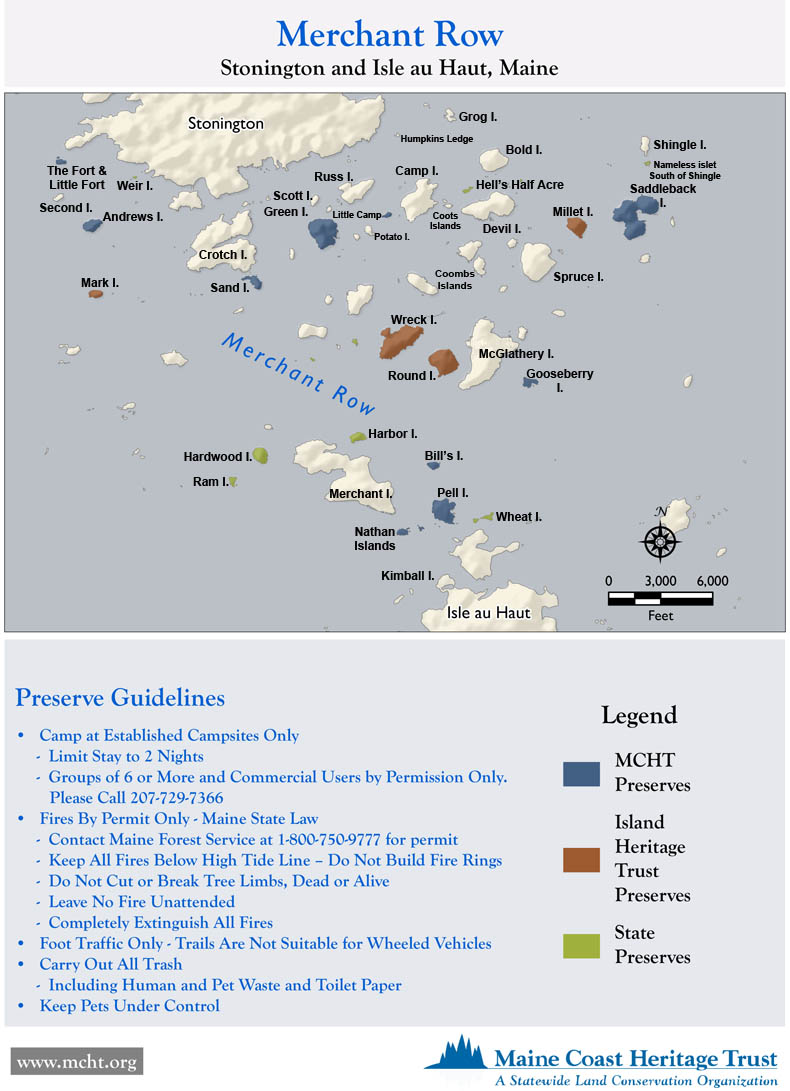
Stonington Days
By David Eden and Tamsin Venn
We set out on for another day of paddling the beautiful Deer Isle archipelago. The Stonington islands are without a doubt one of the most beautiful places to paddle on the Maine coast. Pink granite ledges in giant shapes rim spruce bedecked islands, like perfect sculpture, spruce bows hanging over solid rock. Pocket beaches of sand and shell lead to lush grass meadows, ferns, wildflowers, raspberries, with lichen-covered granite slabs and views of a nearby island, each inviting picnicking and sunbathing.
Not having been here for several years and with COVID intervening, it felt like balm to the soul, paddling among these familiar islands again.
Last time, we stayed at Old Quarry campground, which, alas, is no more. This time we rented a small cottage above Stonington, the plan being to roll our kayaks down to the put-in every day.
The town put-in is located at the all-tide Colwell Ramp off Seabreeze Avenue, next to the Isle au Haut ferry terminal, on the east side of town. It turned out it was a tad too far to roll to, especially since the return involved a very steep climb up the hill past the Opera House. So we drove to the ramp and unloaded the kayaks, then one of us drove the car back to our cottage and walked back to the put-in. Parking is very limited at or near the Colwell Ramp. There are several pay-to-park sites near the center of town.
For on-street parking, after Sept. 2, you can park for an unlimited time. During summer it's only four hours, 8-5. A municipal lot at the end of Pink Street provides a limited number of free parking spaces, but may fill up.
The town dock by the Harbor View grocery store , where many of us used to launch from and park, does not allow kayaks or other craft to launch there. Dock launches have never been our favorite, so no great loss there. It seems the town is accommodating kayakers, but directing them away from downtown.
We saw several couples and groups out paddling and many cars going by with "real kayaks" on the racks. Sea kayaking is alive and well in Stonington.
Also, kayaking in Stonington is well served by long-time contributor and advertiser Peter Jones of Driftwood Kayak.
Jones remarked that business has been relatively brisk this summer, and describes people as being frantic to get out and have experiences after being cooped up for the past 17 months, and kayaking is on the list, with other activities as well.
He also remarked that people prefer to just wander around the islands and not try to make great distances. One client was here for an Iron Man contest, and Jones expected to lead a marathon expedition. Not so. The clients just wanted to meander.
We followed this precept ourselves, preferring figure eights around various islands, and keeping track of names, stopping here or there for a view or snack on the public access islands, and even having an extended picnic.
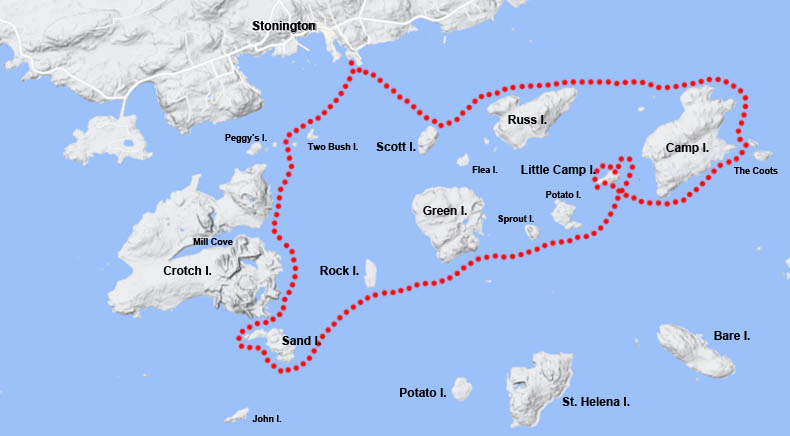
Day 1 — Sunday, Aug 29.
It was a wonderful feeling to be back on the water in Stonington. Details from decades of adventures in this area came back to me as we turned southwest towards Crotch Island, the main quarry for Deer Isle granite. The quarry, opening in 1879, exploited the beautiful, rose-colored stone of the local pluton. Although the quarry closed in the 1960s, it reopened to fill the demands of homeowners who wanted the lovely stone for their fireplaces and countertops.
After passing between the islets of Peggy's and Two-bush Islands, we passed the mouth of Mill Cove, the "crotch" that nearly splits Crotch in two. All along the shore of Crotch are huge piles of waste rock, squared chunks ranging in size from cobbles to monoliths ten or more feet across, which for some reason were not considered suitable for whatever job was at hand.
Incidentally, smaller versions of these piles can be found on the shores of many of the other islands in the Deer Isle archipelago, as other quarries were worked on them. Little other trace of what was once a wide-spread industry here remains on these other islands, as time and nature clothed the works in trees and grasses that found a rich source of nutrients in the rock dust covering the surface.
We passed between Thurlow Head, the southernmost point of Crotch, and the unquarried stone of Sand Island, a ten-acre preserve of the Maine Coast Heritage Trust (MCHT), more than a mile west of the launch. Relatively flat, the shoreline of the island includes bold granite ledges and a few sandy pocket beaches. The beach on the western side is quite wide and a nice place to land and picnic. We have camped there in the past, but it is no longer allowed. We passed the beach by this trip, rounding the southern end and heading east towards Green, nearly a mile beyond.
It was here that we saw the seal. Tammy saw the usual dog-like head staring at us before it slipped under the surface. I missed that, but got my view, and a start, when the same seal surfaced not twenty feet away and dove in fright with a great slap and splashing.

Top row: Heading west through the anchorage. Piles of reject stone line Crotch Island. Some of the stone was organized to make piers.
Row 2: Tammy contemplates a sand pocket beach and un quarried stone pillows on Sand Island.
Row 3: 1&2 — On the way past Sand. 3 — Now where? Paddling around the archipelago can be very confusing without a chart.
Row 4: In our little landing spot on the east end of Little Camp, we discover a sign that fills us in on dos and don'ts and admire the evidence of violent past vulcanism.
The passage to Green was otherwise uneventful. Leaving the small Rock Island to our left, we passed by on its south coast. Green is another island we have landed on several times, especially when paddling with the kids, as there is a lovely little quarry hole in the middle filled with fresh water, a wonderful place to stop and swim on a hot summer day. Not so hot today, and we wanted to cover as much water as we could, so we aimed for Camp Island, another mile or so beyond.
There are a few small islands between Green and Camp, including Sprout and Potato (whoever named them must have been wanting their dinner!) The third is Little Camp Island.
Little Camp is another MCHT island. At 2.8 acres, it is largely treeless and also relatively high, so that you get a wonderful view of the surrounding islands from the top. (Russ used to be the go to island for great such, but the top, once kept clear by sheep, had grown up a lot the last time I was there and felt much less open than Little Camp.)
The best landing spot is the large beach, protected by offshore rocks, on the south side, Unfortunately, two other paddlers had just landed there, so we rounded the western end and pulled up on a much smaller beach for lunch.
There was no way to the top from our lunch spot, so we continued to round the island after eating, hoping that the other paddlers had left. Yay! They had, and we quickly pulled up onto the soft sand beach. "Sand," in this part of Maine, is often enriched and softened by millions of tiny shell fragments added to the ground rock and quartz sand more familiar to beach goers.
The climb to the top led to a gorgeous view, and we reveled in the vistas for several minutes before climbing back into our boats and continuing eastwards.

Top row: More rock pillows, carved by frost, sand, and seawater. Looks like a dandelion — sorta. At the main landing, David indicates the trail to the top.
Row 2: Panorama from the summit of Little Camp.
Row 3: Tammy enjoys the view. The "Yellow Brick Road" — lichens on granite, making future soil. David gets a loud send-off as he heads towards Camp Island.
We continued around the east side of Camp, a pretty island with a house and pier. Across a narrow channel are the Coots, tiny islands we would paddle between later in the week.
The smaller islands of this area are a delight to paddle in and around. They are often jewel-like in their wild beauty, formed of pillowed pink and gray granite, with spiked firs, larches, and pines forming a staccato skyline of dark green, and ferns and grasses a gentler hue above the smooth rock. At low tide, golden necklaces of dangling rockweed and sometimes lovely sand beaches give an almost tropical air to the region. A dip in the water will remind you that this is actually a northern scene that can easily descend into a harsh reality that local fishers and lobsterers must contend with every day.
We leave the Coots behind as we circle around the north coast of Camp and decide to finish our day by skirting Russ on its northern shore and crossing back to the launch from Scott Island.
The last leg of this trip can be particularly hazardous, as this is the channel used by many lobster boats speeding home from their traps to the south. A magnificent sight, these boats have an air of muscular beauty, clean-lined, often burdened with empty traps, and with a crew busy in the stern as the captain stands high and proud at the wheel.
Lobster boats leave an actual groove directly behind them at full speed, and their prows carve a strong wake that can give you quite a bouncy ride. But they are coming home after a hard day on the water, so give them plenty of room. You do not have the right of way, and are actually quite hard to see from the helm of a lobster boat.
It is always fun to return through the anchorage at Stonington and to read the names and admire the lines of the working boats at anchor. This is not much of a mixed harbor. Working craft are in the strong majority.
Distance/Time: 7.1 miles/3.5 hrs.
Tides: High 4:22 a.m. 8.761 ft., Low 10:27 a.m. 1.604 ft. : High 4:41 p.m. 9.236 ft, low 11:05 p.m. 1.389ft.
Weather: Cloudy, rising SW wind to 10-12 knots. Low to mid 60s F.
Animals: Seal (twice), Osprey, many lovely little Guillemots, gulls of various ilks, comorormorants (as son Anton used to call them), and a couple of juvenile Eiders.
Islands Stops: Little Camp.

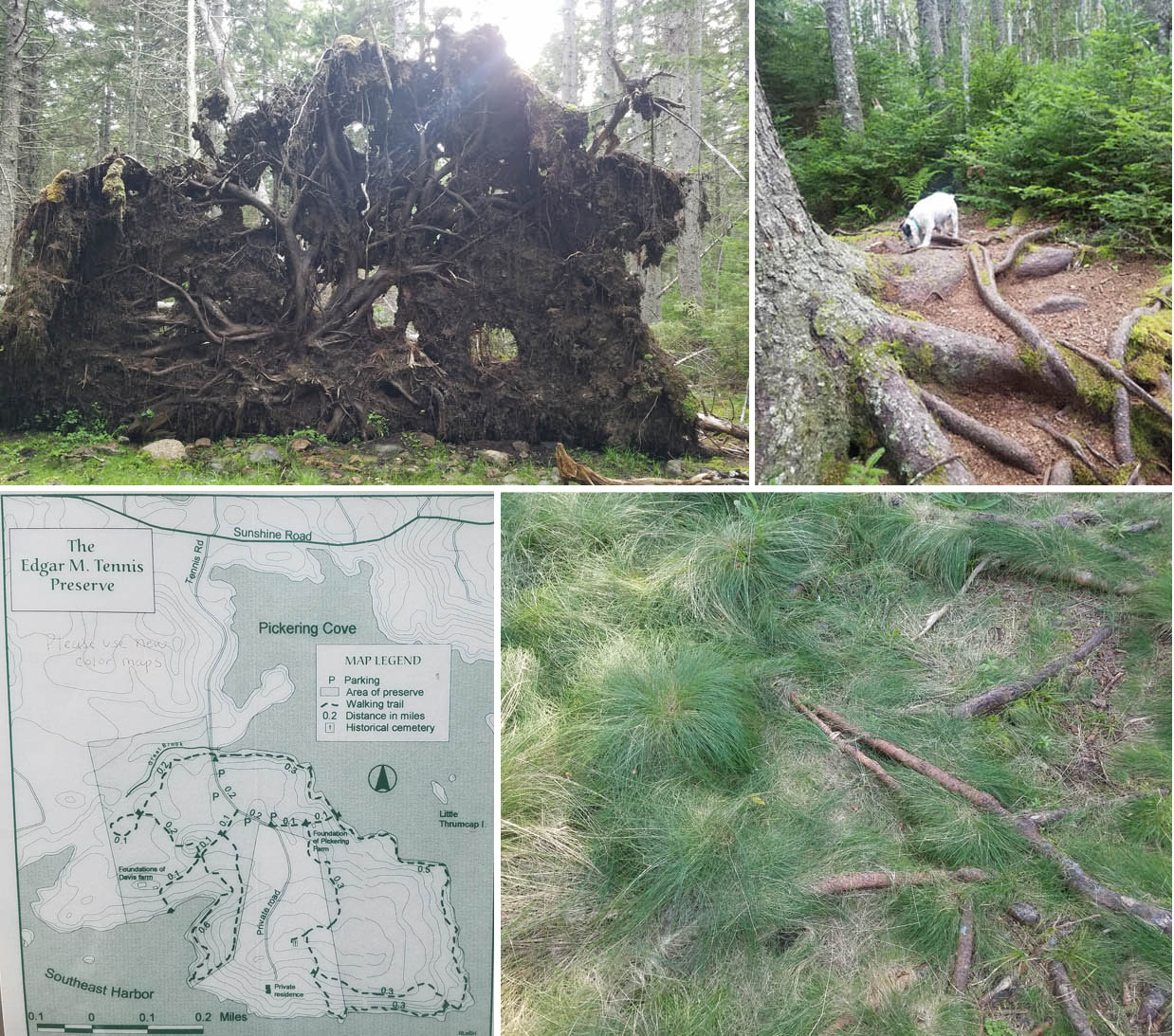
Top row: The soil on Maine's islands is often extremely shallow, leaving trees extremely vulnerable to blowdowns. Millie picks her way along the rough trail.
Row 2: The map of the preserve is posted at most trail junctions. Tufts of grass look like green tribbles taking over the forest floor.
Day 2 — Monday, August 30.
There will be days on Deer Isle which are just not as nice for paddling as others. If you are not camped on an island, hunkering down in your tent and hoping it will not blow away, there are plenty of walking trails around, as well as numerous art galleries. If the weather is really awful, there's always Scrabble.
We took in the Edgar M. Tennis Preserve in Mountainville. There are several trails that lead around and across the peninsula. Of special interest are the ruins of two farms, now reduced to granite block foundations.
Two must visit sites are the Granite Museum, in Stonington, and Nervous Nellie's Jams and Jellies, in Mountainville. The former is, unfortunately, currently closed because of COVID. The latter is open and was doing a booming business, although the open jars and crackers for tasting are gone for now. Parking is limited. We were at the gates a little before opening and had no trouble, but if the lot is full, you have to come back another time, as there is no road parking.
The selection of jams and jellies is enough to tempt us back each time we visit Deer Isle, but, for me, the main draw is Peter Beerit's mad world of fantasy sculptures that create his own universe in the fields and woods next to the shop.

Peter Beerit's sculptures, on the borderline between winsome and sinister, welcome you to Nellieville and are worth a visit even if you don't buy any jam.
Distance/Time: 3.5 miles/2 hrs.
Tides: Didn't matter.
Weather: High winds and rain forecast, so we took a nice, rough hike in the woods with Millie. Many roots, muddy, goopy sections, and rocks.
Animals: One thoroughly muddy Millie.


Day 3 — Tuesday, August 31.
Tuesday called for south/southwest winds 5-10, increasing slightly in the late afternoon. That is counter to the usual summer pattern, where the southwest winds build in the afternoon, up to 15 knots or higher, but die in late afternoon. The mild winds were very welcome. It lets you venture out farther toward Merchant Row.
We put in at the east side of Webb Cove on Buckminster Neck and headed southeast to Grog Island, the biggest target in this area of the Deer Island Thorofare besides several rocky ledges. From Grog we followed the west side of Bold passing Hell's Half Acre to the west (unnamed on the chart). Three one-tenth-of-one percenter boats (pandemic splurges?) were anchored just off shore, one yacht and two motor vessels, a total of about $3 million worth of boats I reckoned.
David said that he did not remember ever seeing so may very large boats here.
We left Devil Island to starboard, eyed Millet and Saddleback to the southwest, but crossed to Buckle, a steep-sided bold island overseen by Maine Island Trail Assn. (MITA). We got stopped by shell ledges and seaweed at low tide between Buckle and Spruce, so crossed to the twin Coombs Islands to the east, negotiated the passage between in a couple of inches of water covering bleached shell fragments. Then we sashayed over to Camp, through the passage between the Coots, two other small islands not named on the chart, in shallow but passable water, and over to the south side of Hell's Half Acre, making our way through seaweed draped boulders to the sparkling crushed shell beach on the north side. We pulled the kayaks effortlessly onto shore, calculating incoming tide, giving ourselves about an hour. After a brief plunge into the water — note the water is remarkably warm this year, about 60 degree surface temperature, and one can almost dog paddle around, almost. While good for swimming, the water temp is not a good sign for the Gulf of Maine's warming waters and how even a few degrees warmer for both surface and bottom temperatures, is causing havoc with the fisheries.
Exploration is a breeze on flat Hell's Half Acre, probably the most popular island in this area. We landed on the extensive low-tide beaches on the south side. You just pass through the thinning spruce to the north facing "beach," actually largely a smooth shelf of granite extending below the low tide mark. Here, you will also find MITA's two tent platforms set back from the shore. We dried out, explored, had lunch, and signed the guest book. In profusion were Rosa rugosa hips and wildflowers.
Thank heavens for MITA and the other organizations managing many of these islands for public access.
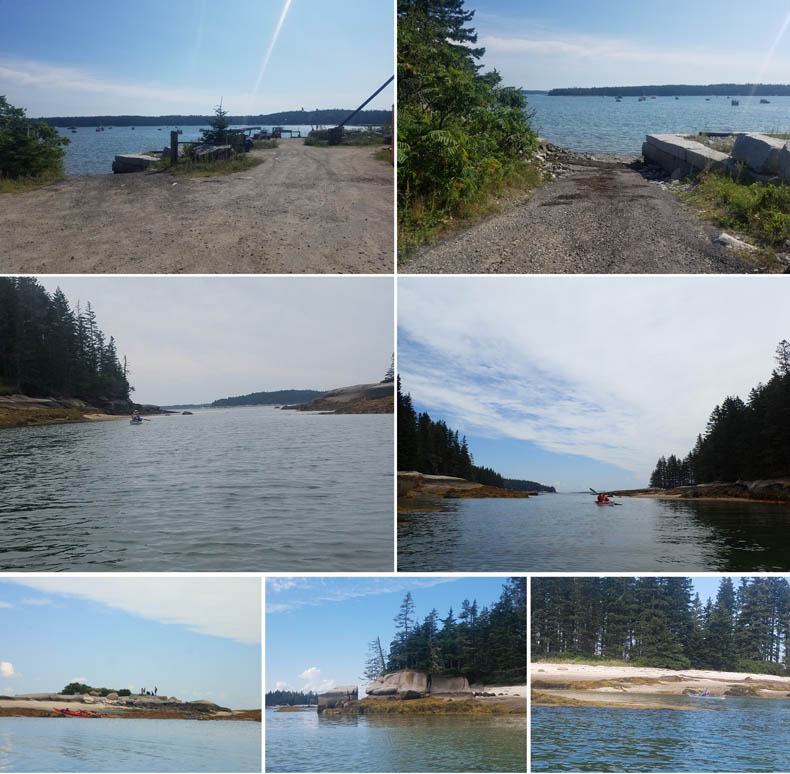
Top row: The "new" town launch in Webb Cove — better than nothing.
Row 2: When you get right down to it, we are so very, very small compared to this planet. How can we damage it so thoroughly? — between the Coombs.
Row 3: Low tide increases the options for landing and exploring. The west end of Hell's Half Acre. Paddling into the beach on the south side of HHA.
As we ate lunch, a group of spirited young paddlers arrived. It was a freshman group with their two leaders from the College of the Atlantic (COA) in Bar Harbor, out for a week's trip. They were spending the night on the island, then going on to Kimball Island, near Isle au Haut. They made short, cheerful work of unloading kayaks and hauling huge heavy-duty garbage bags of gear across to the tent platforms. That afternoon, the leader planned to practice wet-exit rescues with them off the gently sloping beach.
Returning, we paddled along east end of Camp, over to Humpkins Ledge, and so back to Webb Cove. A swell was running through here, perhaps caused by wakes bouncing off the many ledges, not sure what happens here in heavy seas.
MITA has long stewarded several islands off Stonington. That includes Maine Dept. of Agriculture, Conservation, and Forestry islands — Harbor, Hell's Half Acre, and Steves as well as private islands.
What struck me is the increased access to many other islands as well. A more recent steward providing public access is Island Heritage Trust, a local Deer Isle land trust, which manages Wreck, Round, Mark, and Millet Islands.
Also Maine Coast Heritage Trust manages Saddleback, Green, Sand, Gooseberry, Bills, Nathan and Little Nathan, Little Camp, and The Fort; Chewonki Foundation, Russ Island; Acadia National Park, Duck Harbor Campground and a network of trails on the south end. In general, trails are maintained on the larger islands, more signage is present, more information is provided, and the organizations work together.
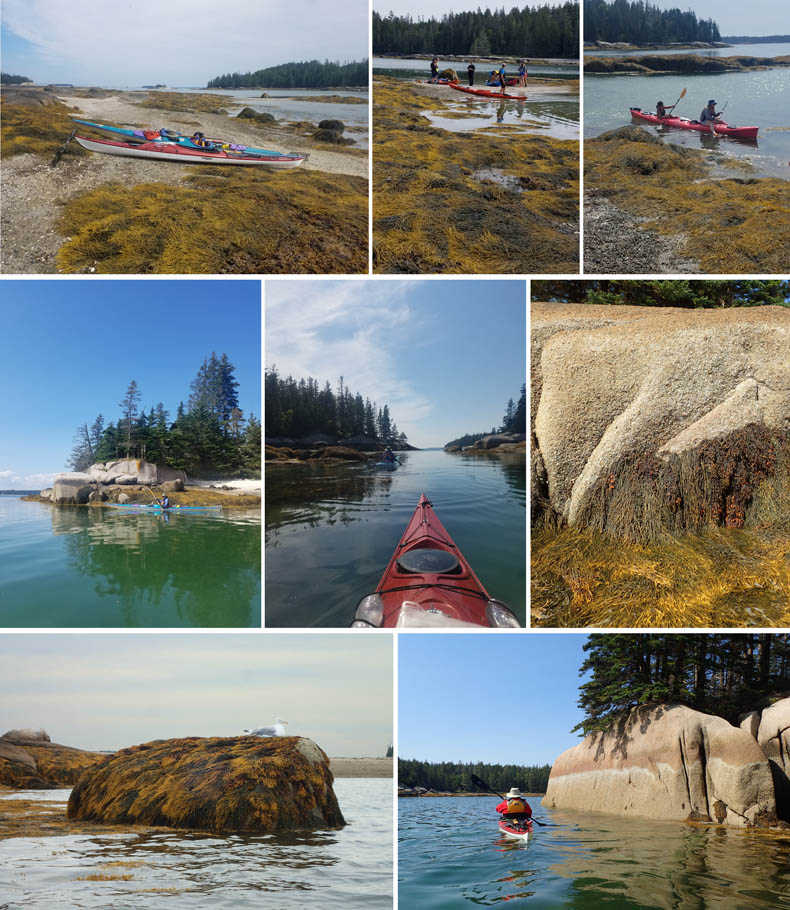
Top row: On the low tide beach of HHA. The COA freshman orientation trip arrives at HHA. Some of the students had never been in kayaks before.
Row 2: Tammy leaves HHA. And paddles between the Coots. Four levels of habitations — rockweed, barnacles, lichens, and forest— form a painting in nature.
Row 3: That the rockweed-covered rock looks like a sleeping bear does not disturb this seagull. David heads towards Camp.
Distance/Time: 7 miles, 3.5 hours
Tides:6:12 a.m. 8.073 ft., Low 12:11 p.m. 2.167 ft. : High 6:27 p.m. 8.921 ft, Low 12:00 a.m. 1.536 ft.
Weather: Cloudy to the south, clear to the north. Winds SSW 5-10 mph, dropping in the afternoon.
Island Stops: Hell's Half Acre
Animals: Two Harbor Seals, Osprey, Great Blue Heron, Guillemots, Herring Gulls, Terns.
Lobster Boats: Many

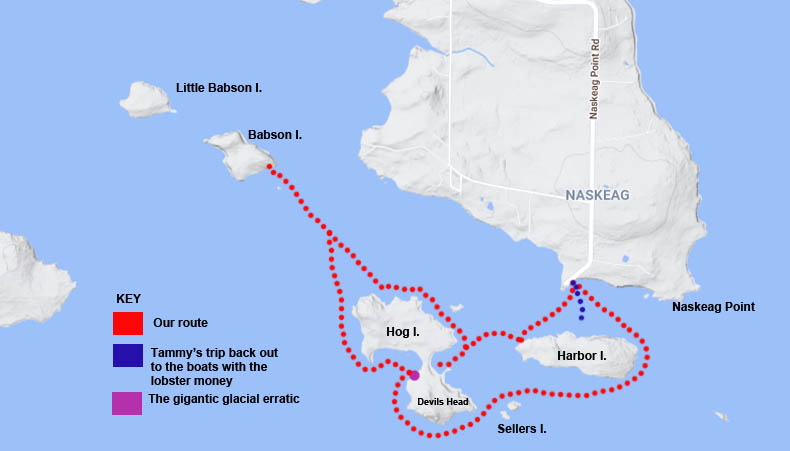
Day 4 — Wednesday, September 1.
Today we joined up with Peter Jones for a trip he was leading with some friends from Swampscott, Mass. This turned out to be quite pleasant, as we knew some of the same people and locations, as Swampscott and Gloucester, Peter's winter quarters, are not that far from Ipswich.
We were supposed to meet at 9:30 at the beach launch at Naskeag Point. Unfortunately Steve, a lawyer, and Laurie, an author of children's books, were moving their digs between peninsulas and didn't arrive until nearly 11:00. Tammy and I relaxed in the shade, she by the pier, and I in the shade of a grove of apple trees on the site of the Battle of Naskeag memorial stone. I had the better spot, as there were plenty of nearly ripe apples to munch on.
While waiting, I discovered that I had left my water behind. Bad move on this hot and sunny day. Fortunately, David and Deb, two paddlers from Tennessee, gave me two fresh bottles. We chatted amiably until they rolled their Hobie boats down to the water and pedaled off with their paddles strapped to the side.
Finally all were equipped and gathered together at the water's edge; Peter had given the usual outfitters talk on technique and safety; the wind had risen from near dead calm to quite a stiff breeze; and we launched at 12:00 noon.
The first leg was extremely short, less than a half mile to a sand beach on Harbor Island. This had been advertised as an easy trip, and so it was. We sat on the rocks on shore and had a barely earned snack.
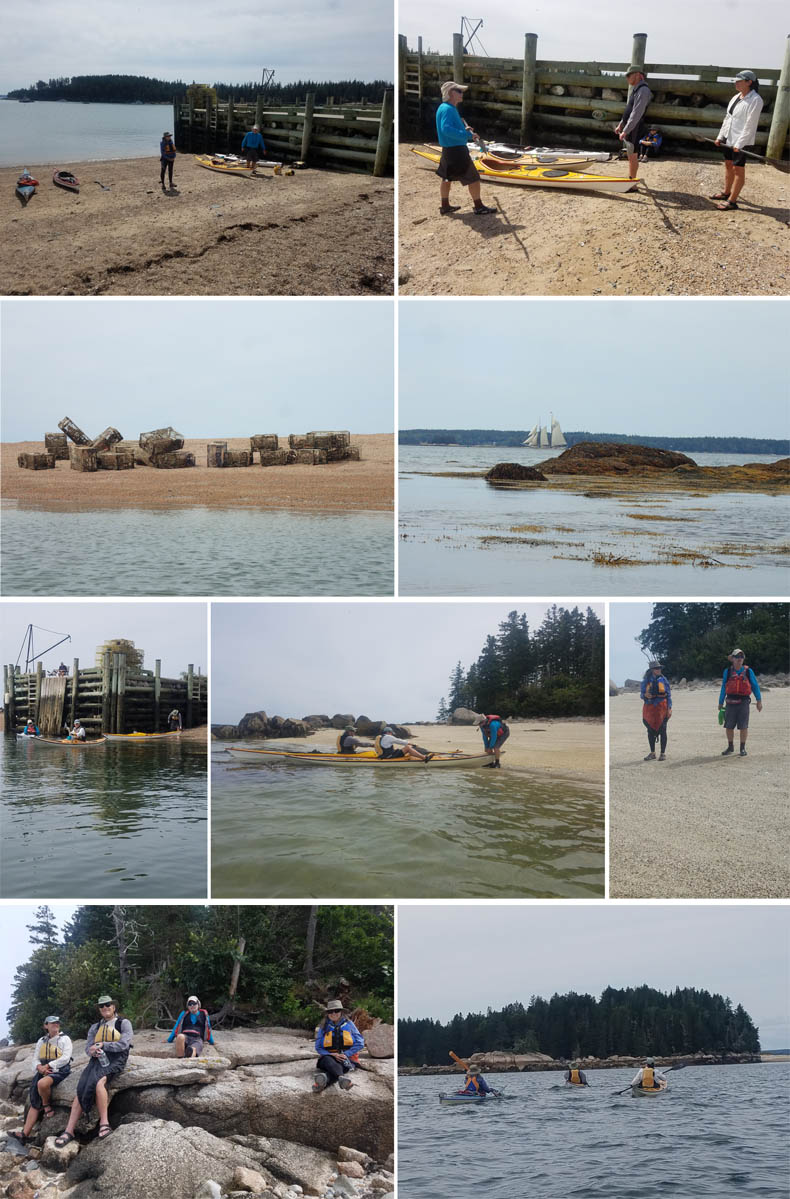
Top row: The designated launch for kayaks on the left side of the pier at Naskeag Point, Harbor Island in the distance. Peter instructs Steve and Laurie.
Row 2: Lobster traps on the beach form a rough-hewn still life. A Maine schooner beats down Eggemoggin Reach.
Row 3: On the water at last. Landing on the beach at the western tip of Harbor Island. Tammy and Peter discuss the route from here.
Row 4: Snacking on the rocks of Harbor Island. Our lunch stop will be the beach at the right of the picture, on Babson.
After a few, we moved on and paddled into the cove on the east side of Hog Island. Hog is a "spectacle" island: A similar cove on the west side nearly splits the island in two. The shape on the chart is roughly similar to a pair of pince nez spectacles. As we neared the shore, we saw a Great Blue Heron standing facing us with his head pointing straight up. I have always thought that was to bring both its eyes into use, giving it binocular vision. At any rate, it didn't like what it saw and took off in that peculiarly awkward heron way, with its body already in flight and its legs pointing to the ground.
Our next stop, for lunch if the snack hadn't filled us, was at the southeastern point of Babson Island, somewhat less than a mile farther on. This had a nice sand and pebble landing beach. A short walk of about 100 yards on a woods trail or along the beach led to a rustic stair giving access to the interior. The top of the stair led to a real surprise: a fern "bald," the largest I have ever seen. The only other one is on Pickering Island off the south coast of Little Deer Isle, and that is nowhere near the extent of this one. I have been unable to discover how these balds develop. Good dissertation topic for one of those COA students.
We took a slightly different route on our return. Passing the same pair of cute two bush islets we passed on the way in, we headed for the west side of Hog Island. While we didn't land, we did pause to marvel at the gigantic glacial erratic on the shore, at least 30 feet high. While one is always aware that Maine's topography has been largely influenced by the glaciers, the site of this enormous chunk of granite slung casually aside really underscores the power of a mile or more of traveling ice.
Circling back out of the cove, we proceeded to cross to the back or south side of Harbor, leaving the two islets forming Sellers Island on our right. We soon rounded the eastern end of the island and headed into the anchorage.

Top row: The landing on Babson. They don't mention dogs. The rustic stairs off the beach.
Row 2: Our boats drawn up on the sand. The alternate route to the stairs over the rocky beach. The fern "bald" in the interior of the island.
Row 3: Passing the little two bush island on our return. Approaching the point on the southwestern end of Hog Island.
Row 4: The really ginormous glacial erratic on Hog. Paddling up the coast of Harbor Island.
Row 5: More paddling along Harbor. We re-enter the anchorage in the lee of Harbor Island. Tammy buys a brace of lobster from the men on the float.
There were a couple of lobster boats unloading the day's catch tied up to a float in the center of the harbor. It has always been an interesting practice of ours to buy our Maine lobster dinner directly from the lobsterers who pulled it out of the sea. In the past, we have approached the boat out on the water directly, while the crew was still tending their pots.
This case was slightly different, as the men were not in their boats, but on the float. It was the next best thing, as the critters had been caught that same day and the purchase was done "in the raw," without the benefit of fishmongers dressed in white aprons serving behind glass-topped cases.
Our lobsterer was definitely "in the raw" (rough hewn), although it would have made a better picture if he had been wearing the tall rubber boots that seem to be sartorially de rigueur for the romantic image of the lobsterman.
Distance/Time: 3.5 miles/2 hrs.
Tides: High 7:12 a.m. 8.344 ft., Low 1:14 p.m. : High 2.326 7:25 p.m. 9.385 ft., Low 1:03 a.m. 1.632 ft.
Weather: Hot, sunny, very light SE wind, changing to mostly cloudy and chillier, SW wind 10-12 knots.
Animals: Three seals; many oh-so-cute Guillemots; Great Blue Heron; young Osprey repeatedly striking at and missing fish; Kingfisher; fisher cat on shore; immature Bald Eagle.
Island Stops: Harbor, Babson.

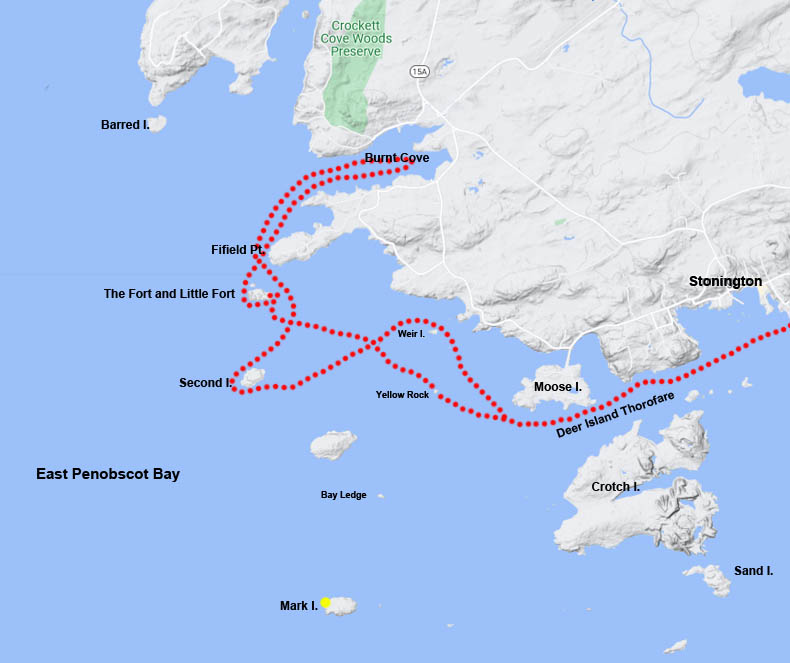
Day 5 — Friday, August 3.
Our final day of paddling was bittersweet — just hate leaving this beautiful archipelago.
The day called for north/northwest winds 10-15 as the front cleared out Hurricane Ida's remnants. Morning view of Stonington Harbor from the cottage was hardly inviting, dark roiling clouds over Isle au Haut, black ripples in the sea, no billowing sails in sight. We launched early afternoon at the Colwell Ramp, and the place was hopping with kayakers.
The goal was to paddle west across Stonington Harbor, then follow Deer Isle's western shore up to Stinson Point and Barred Island, hoping the angle of the land mass would block the north wind, especially if it started gusting to 20, as predicted on one NOAA report.
The water was lively but tame and, as the afternoon progressed, the winds dropped, but the dark clouds with ominous rainstreaks stayed put over the Fox Islands to the west.
The west side of Deer Isle has an appeal of its own. As you paddle along the south shore, you pass Billings Marine on Moose Island, and look out to Mark Island with its lighthouse and near continuous mournful moan.
Here is what Lighthouse Friends has to say:
"Deer Island Thorofare is a narrow passage that runs between the southern end of Deer Isle and numerous offshore islands and ledges. This important waterway links East Penobscot Bay to the west with Jericho Bay to the east and is one of many popular inland passages along the coast of Maine. Tiny Mark Island is located at the western entrance to the passage, and in 1855, W.B. Franklin, Lighthouse Inspector for the First District, recommend that $5,000 be requested for establishing a light on the island to 'enable vessels to cross Isle au Haute bay, and get into Deer Island thoroughfare.'"
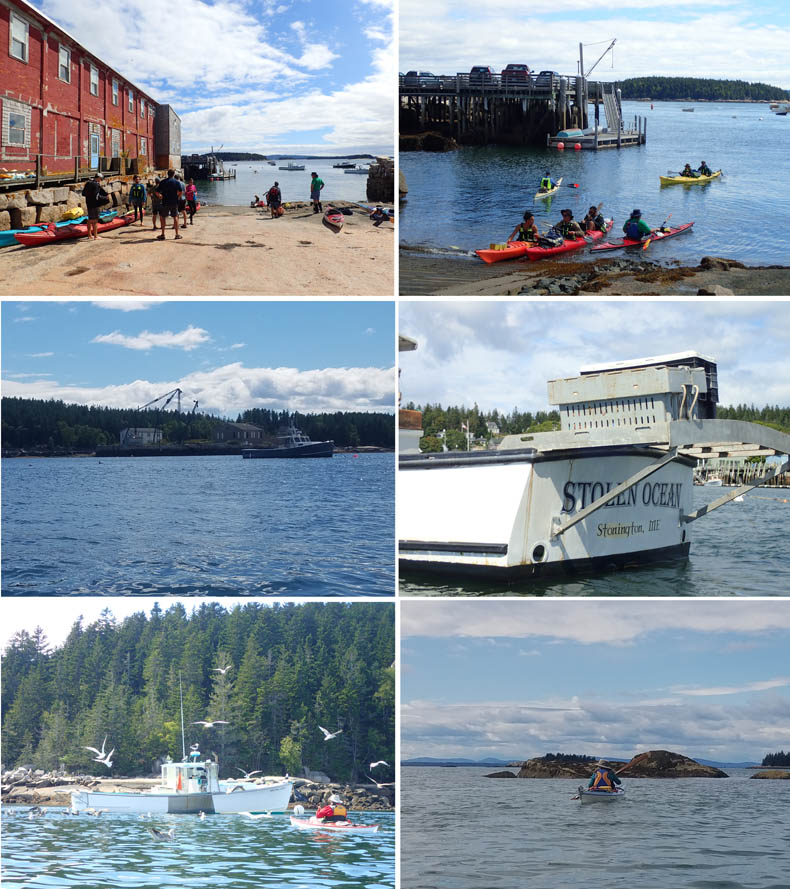
Top row: Colwell Ramp was extremely busy on the day after Ida passed by.
Row 2: The still active quarry office on Crotch. Some of the lobsterboat names are clever, if obscure. Stolen Ocean is a nice change from the usual wife, girlfriend, or mother.
Row 3: "Paddle through the seagulls," says Tammy; she didn't realize they were diving for large floating gobbits of rotting fish. Out of the Thorofare, Tammy approaches Yellow Rock, with the Fox islands in the middle distance and the Camden Hills beyond.
Two other broad islands, Andrews and Second, dominate your view as you travel north. We took a break on The Fort, landing just as another party of kayakers was taking off. This delightful island is just across from Fifield Point and the entrance to Burnt Cove. The low-tide-only shell beach landing is on the east side, and a sturdy set of stairs leads up to the narrow, well-trodden trail through a meadow of raspberry and bayberry bushes with a sprinkling of goldenrod and purple aster blooming at summer's end. The trail leads to the top of the island and gives you a good view of Second, Andrews, and Mark. We could see the people who were here just before us making their way over to the broad granite ledge at the west end of Andrews.
The Fort is a three-acre island with two sand beaches and includes Little Fort, a tiny rocky islet accessible to the north during low tides.
According to MCHT, Fort was formerly named Sheep (one of several around Deer Isle) and used for grazing into the early 20th century. It was renamed Fort due to sound of gunfire from duck hunting years ago. A weir on the north end provided bait herring for many years, into the 1970s. Two generous owners gifted the island to MCHT, with the transaction completed in 2005, for which kayakers like us are eternally grateful.
After an explore and dip on The Fort, we crossed over to Fifield Point, then into Burnt Cove to admire the lobster boats. We paddled back out — no Barred Island today — and returned north to Stonington. The wind had died, and we were in awe of the evening’s shifting light display of brilliant sun and dark shadow. It was a good end to a very restorative week, paddling among just a few of the many islands — 50 in all — that lie between Deer Isle and Isle au Haut.

Top row: The low-tide beach landing on The Fort. Tammy gets ready to explore the little island.
Row 2: The stairs from the beach. Goldenrod (Solidago nemoralis), purple asters (Symphyotrichum puniceum), and bayberry (Myrica sp.) add color to the end of summer on The Fort.
Row 3: View from The Fort: Isle au Haut in far distance, Andrews, Mark, Second islands. The lump of rock known as Little Fort.
Distance/Time: 8.5 miles/3.75 hrs.
Tides: High 9:00 a.m. 8.771 ft., Low 3:02 p.m. 1.849 ft. : High 9:10 p.m. 10.023 ft., Low 2:52 a.m. 1.168 ft.
Weather: Cloudy with N-NW wind 10-15 knots, with wind fading and patchy sun later in the afternoon.
Island Stops: The Fort.
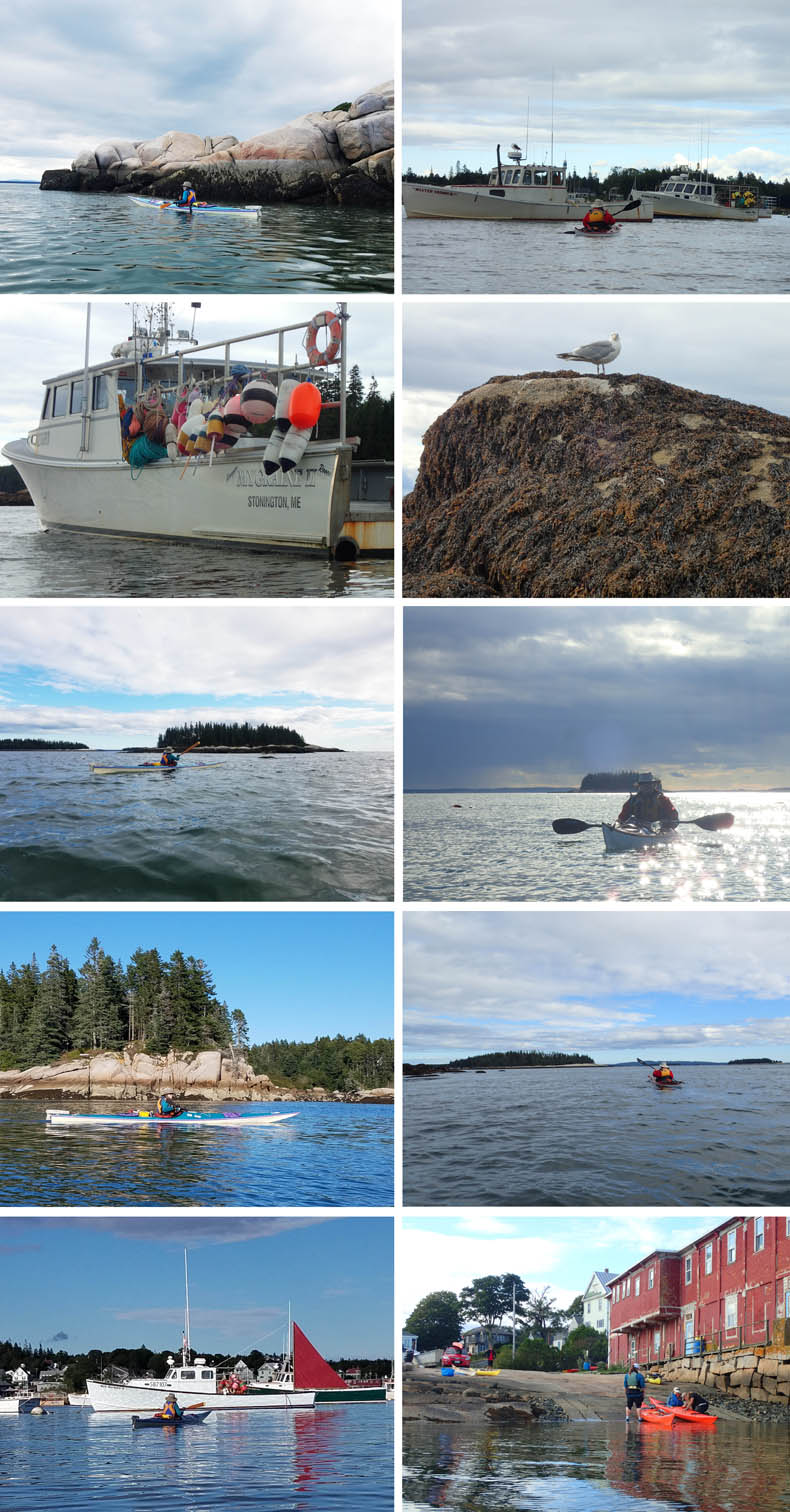
Top row: Tammy rounds the end of The Fort. Entering the anchorage in Burnt Cove.
Row 2: Some lobster boats can almost be categorized as found art. A seagull watches warily as we leave Burnt Cove.
Row 3: Tammy heads out towards Second Island. And David paddles back through sparkling wavelets lit up by the westering sun.
Row 4: Travelling south along Deer Isle's western coast. Approaching the entrance of the Thorofare.
Row 5: Back in the Stonington Harbor; the mizzen sail helps keep the lobster boat oriented while the captain in working the traps. The ramp is still as bustling as before when we return after nearly four hours.
|


















